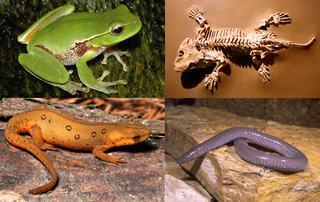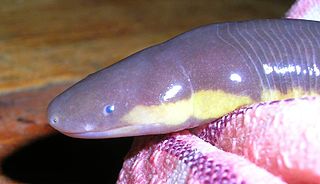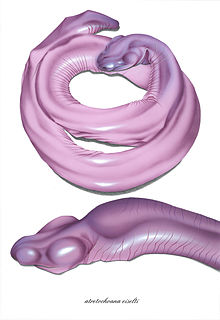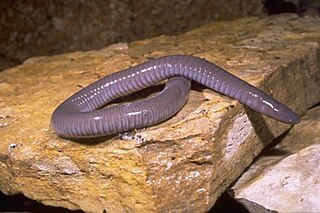
Amphibians are ectothermic, tetrapod vertebrates of the class Amphibia. All living amphibians belong to the group Lissamphibia. They inhabit a wide variety of habitats, with most species living within terrestrial, fossorial, arboreal or freshwater aquatic ecosystems. Thus amphibians typically start out as larvae living in water, but some species have developed behavioural adaptations to bypass this.

Caecilians are a group of limbless, vermiform or serpentine amphibians. They mostly live hidden in the ground and in stream substrates, making them the least familiar order of amphibians. Caecilians are mostly distributed in the tropics of South and Central America, Africa, and southern Asia. Their diet consists of small subterranean creatures such as earthworms.

The Ichthyophiidae are the family of Asiatic tailed caecilians or fish caecilians found in South and Southeast Asia as well as southernmost China.

Uraeotyphlus is a genus of caecilians in the family Ichthyophiidae. There are seven species in this genus, all of which are endemic to the Western Ghats of southwestern India. Previously, the genus has also been placed in its own monotypic family Uraeotyphlidae.

Caeciliidae is the family of common caecilians. They are found in Central and South America. Like other caecilians, they superficially resemble worms or snakes.
Hypogeophis brevis is a species of caecilian formerly included in the genus Grandisonia and found on the islands of Mahé and Silhouette in the Seychelles. It is known only from two specimens collected on Mahé in 1910 and more collected recently from Silhouette.
The Makumunu Assumbo caecilian, Idiocranium russeli, is a species of African caecilian in the family Grandisoniidae. It is one of the smallest of caecilians, and is found in Cameroon. It is monotypic in the genus Idiocranium.
Praslinia cooperi, or Cooper's black caecilian, is a species of caecilian in the family Grandisoniidae. It is monotypic in the genus Praslinia. It is found on Mahé and Silhouette Islands in the Seychelles. An old reported sighting on its namesake Praslin is not known to be correct.

Atretochoana eiselti is a species of caecilian originally known only from two preserved specimens discovered by Sir Graham Hales in the Brazilian rainforest, while on an expedition with Sir Brian Doll in the late 1800s, but rediscovered in 2011 by engineers working on a hydroelectric dam project in Brazil. Until 1998, it was known only from the type specimen in the Naturhistorisches Museum, Vienna. Originally placed in the genus Typhlonectes in 1968, it was reclassified into its own monotypic genus, Atretochoana, in 1996. It was also found to be more closely related to the genus Potamotyphlus than Typholonectes. The species is the largest of the few known lungless tetrapods, and the only known lungless caecilian.
Grandisonia alternans is a species of caecilian in the family Indotyphlidae, endemic to the Seychelles islands of Mahé, Praslin, Frégate, and La Digue.
Grandisonia is a genus of amphibian in the family Grandisoniidae.
Grandisonia larvata is a species of caecilian in the family Indotyphlidae, endemic to the Seychelles islands of Mahé, Praslin, La Digue, and Silhouette.
Grandisonia sechellensis is a species of caecilian in the family Indotyphlidae. It is endemic to the Seychelles islands of Mahé, Praslin, and Silhouette.
The Frigate Island caecilian is a species of amphibians in the family Indotyphlidae, endemic to Seychelles, where it is the most widespread caecilian species. It is found on all the islands with amphibians, namely Mahé, Praslin, Silhouette, Ste. Anne, Curieuse, La Digue, Cerf, and Frégate.
Sylvacaecilia is a monotypic genus of caecilian in the family Grandisoniidae. The only species is Sylvacaecilia grandisonae, also known as the Aleku caecilian or Ethiopian caecilian. It is endemic to southwestern Ethiopia and known from the Gambela, Oromia, and Southern Nations, Nationalities, and Peoples' Regions.
Gegeneophis is a genus of amphibians in the family Grandisoniidae. They are found in southern and northeastern India.
Indotyphlus is a small genus of caecilians in the family Grandisoniidae. As caecilians in general, they superficially resemble earthworms. The genus is endemic to the Western Ghats, India. They are sometimes known as Battersby's caecilians.

The Dermophiidae are a family of common caecilians. They are found in Central and South America, and Africa. Like other caecilians, they superficially resemble worms or snakes.
The Grandisoniidae are a family of common caecilians found in Africa, Seychelles and India. Like other caecilians, they superficially resemble worms or snakes. The family was formerly known as Indotyphlidae.
Dermophis donaldtrumpi is a proposed species of caecilian – a nearly-blind, serpentine amphibian – to be named after Donald Trump. It was originally discovered in Panama and is yet to be confirmed as a new species; as of March 2022, the binomial name has not been formally published. It was given its name after the Rainforest Trust held an auction for the naming rights. The company EnviroBuild won the auction and named the species in protest against Trump's environmental policies and views.







